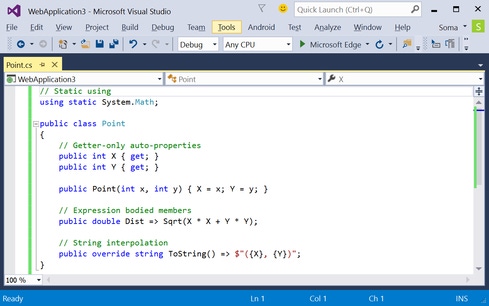Microsoft has released the latest version of Visual Studio, as well as .Net. These help to expand the company's developer ecosystem to new platforms, including OS X and Linux.


6 Top Programming Languages For Mobile Development
6 Top Programming Languages For Mobile Development (Click image for larger view and slideshow.)
This week, Microsoft released Visual Studio 2015 and .Net 4.6, a pair of developer tools that have been under development since last June.
Visual Studio is a developer ecosystem aimed at producing code that runs on all major platforms. It allows development to be done on Microsoft Windows, Mac OS X, or Linux.
This latest iteration of Microsoft's Visual Studio, which the company announced in a July 20 blog post, includes mobile development tools that allow programmers, using their own preferred languages, to build applications for iOS, Android, and Windows phones. VS 2015 offers support for C# 6, VB.NET 12, ASP.Net 5, and F# 4, as well as improved support for C++, TypeScript, and Python.
Specific tools for Windows 10 are expected on the July 29 release date. While Microsoft has been busy publicly marketing the new version of Windows for consumer use, the release of the new version of Visual Studio and developments from its partners conference earlier this month show the software giant is preparing developers to work with the new OS and expand its ecosystem.
Visual Studio Community is an integrated development environment (IDE) that produces code that will run on Windows, iOS, and Android. Web applications and cloud services can also be generated. Building Web applications in the IDE by using the Node JavaScript server-side runtime environment is now possible.
The VS Community is free for individual developers, open source projects, academic research, education, and small professional teams.
Visual Studio Code is the standalone and somewhat basic code editor of VS 2015 that runs on Windows, Mac OS X, and Linux. It is a simplified IDE usable for more straightforward coding situations.
VS 2015 incorporates the Roslyn .NET compiler, which includes new debugging methods. The Rosyln-based Light Bulbs feature can proactively suggest fixes to broken code or ways to improve running code. Roslyn also allows developers to customize warnings and suggestions.
Three separate diagnostic windows used in debugging are now integrated into one diagnostic tool window. The diagnostic tools in this window bring out information in two complementary ways: By adding graphs to the timeline in the upper half of the window, and by providing detailed information in the tabs in the bottom half of the window.
[Read about Microsoft's Cortana analytics tool.]
These graphs allow selection of a time period to investigate further.
PerfTips is a new feature that returns performance metrics about how a program is running up until a breakpoint is set by the programmer.
Team management and DevOps services like Visual Studio Online and Team Foundation Server are part of this new overall system. VS 2015 integrates in a more complete manner with them allowing easier deployment and monitoring. The Team Foundation Server 2015 is still in preview, however.

(Image: Microsoft)
It is expected to be released in August.
VS 2015 makes sense for developers that use Microsoft tools. It extends the reach of those tools to other platforms rather than Microsoft's own. This development reflects the desire of the company to move beyond its own desktop platforms to embrace mobile operating systems such as iOS and Android as a way to bring its tools to a new generation of users.
About the Author(s)
You May Also Like







